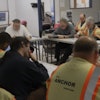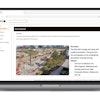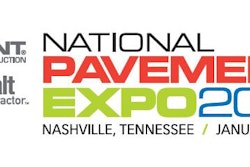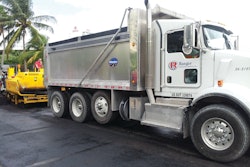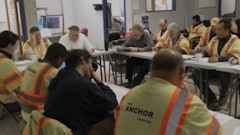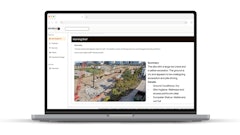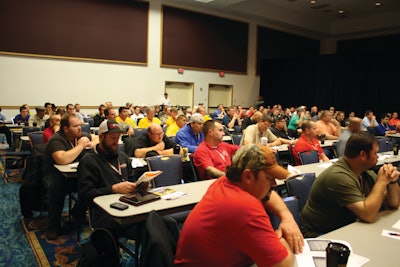
Whether you are a seasoned veteran or new to the pavement maintenance industry, the seminars and demonstrations at NPE 2014 were filled with several new tips as well as a few refreshers to help contractors find success with their business? or maybe even start down a new path with their new found knowledge.
1. You can control everything but the weather.
For the first time since 1999, The National Pavement Expo (NPE) brought back outdoor demonstrations and 16 manufacturers were on hand and ready to show attendees what their equipment could do to fix the lot at the Greater Fort Lauderdale Convention Center.
The first day of demos were plagued by rain and many demos, including sealcoating, had to be postponed. Once the rain passed through, several companies were able to complete their demos on Thursday and the rest displayed their equipment when the sun came out on Friday
“Hundreds of contractors were able to see the entire spectrum of paving and pavement maintenance equipment put through its paces,” said Allan Heydorn, conference manager and organizer of the demonstrations. “We demonstrated everything from milling and paving to sweeping, striping, sealcoating, cracksealing and infrared repair -- so if contractors wanted to see a technology in action NPE 2014 was the place.”
2. You should be using chalk lines for proper site layout on every job.
Layout work is very important because mistakes made during your layout are easy to correct, paint lines are not. “One bad pavement marking job can affect your business for a long time,” says Robert Liles of Robert Liles Parking Lot Service. Chalk lines should be used on new layouts so you can easily walk around the lot and spot your mistakes before you paint.
3. Site preparation is everything when sealcoating.
A sealcoating application will not stick if the surface is not properly prepared. “You want to clean, prep and prime,” says Cynthia Thompson from Star-Seal of Florida. Spend the time to broom and blow off all the dirt, sand and debris on the asphalt.
Thompson says to look beyond the debris you can see on the surface. “You have got to get down into the profile of the asphalt where the dirt is stubborn and hides,” she adds. “Any sealcoating you lay down will stick to whatever it’s applied to and if that material is dust and dirt, not the asphalt surface itself, then it will lift right up as soon as it’s disturbed.”
“Your reputation will likely suffer if the job doesn’t perform. Call backs are going to cost you a lot more than site prep so clean, clean and clean some more.”
4. It’s all in the mix.
“Pavement design is like a cake mix," says James Curtis of Chec Management Systems in California. "If you do not follow the recipe, it can be disastrous."
Mix related issues can mean the end of your pavement before you even lay it down. Checking, scuffing, cracking, chipping, shoving and rutting can all be issues that occur when you are not using the right mix for the job.
“The mix needs to be stable and strong,” says Jim Scherochman, consulting engineer. “There might not be enough strength within the mix to support the roller or the mix may be internally unstable to cause issues. All of these things can be solved at the plant.”
5. Teach your customers.
Making sure your customers know what they are buying is one of the things that could be heard over and over again in each session. Whether it be sweeping, striping, paving or sealcoating, going cheap is not the way to save in the long run.
Educate your customers about the return on investment when you’re bidding a job. Make sure they know without a doubt what they are getting into. Walk them through the project from start to finish. Customers like hand holding.
“You never want to hear the words ‘I thought’ from your customers,” says Jack Moltz from Southern Emulsions. “If they are saying that, it means they didn’t understand the things you were telling them when you bid the job.”
6. If you're working at night, you're at a higher risk.
A lot of contractors in this industry use the hours of the night to complete work that can’t be done during the day when many businesses are open. From paving to striping, there are many benefits to working at night. There are however, many dangers as well.
Debbie Jacketta, from Jacketta Sweeping Services in Utah uses her sweeping units on highway construction jobs. Her employees will work at night, cleaning up what milling machines have left behind on the roadway. However, an unfortunate incident occurred on a jobsite where one of her workers was not seen while working and was backed over by a dump truck. Jacketta received a visit from OSHA after the incident and they have since changed the way Jacketta Sweeping operates at night.
“We now have a company internal traffic control plan that teaches employees that they should stay in the sweeper while in the active work zone areas for a project,” says Jacketta. “We tell them that if a need arises to exit the sweeper, employees should move out of the work zone area to a safe place before exiting.”
An additional hazard of night work is the danger of employees falling asleep while on the job. Bill Sirous from Circadian Technology says that humans are hard wired to be day creatures, many changes happen in our bodies at night. “Mother Nature is trying to shut you down when you work at night,” says Sirous.
Circadian Technology has studied this biology in humans and recommends companies that do night work develop a “Fatigue Risk Management Solution (FRMS).” These solutions require commitment by the company and the employees, along with training and education. The solutions involve having optimized staffing levels, shift management in case of fatigue, work/rest schedules and a written FRMS with best practices, policies and procedures.
7. Asphalt hotbox reclaimers will pay for themselves very quickly.
“If you’re bringing unused asphalt back to a plant at any point in time, you should purchase an asphalt reclaimer,” says Kurt Schwarz from KM International. An asphalt reclaimer allows you to put in virgin asphalt or plant mix that has not been compacted and re-use it at a later time. It reheats the material to be used when you need it, saving you time and money.
With the help of a reclaimer, you can have hot asphalt year round allowing you to operate on your own time, not the plants. If you need mix for just a few potholes, you will have the ability to do the work how you want and when you want.
8. Three things will destroy a pavement, water, water and water.
First thing is first, get the water out of the aggregate. This relates back to the mix design, but Scherocman stresses that if you don't get the moisture out of the aggregate, the mix is going to be too wet and the binder won't adhere properly to the aggregate particles. That will cause all of the issues mentioned above.
Next, you want to make sure you pre-plan for water on new construction. Study the site layout, make sure there are not low spots for water to pool and cause premature pavement wear.
Make sure you achieve proper compaction. Compaction shrinks or eliminates voids so less water can enter the structure.
Watch the weather (and turn off the sprinklers!) When you’re sealcoating a job, be sure to watch for rain. There should not be any water on the new surface within eight hours of application. This also means to call ahead to the property managers and have them turn off the sprinklers for the days before, on and after when you plan to sealcoat.
9. No pavement will be better than what you build it on.
Up to 90% of the strength of a road or parking lot will be provided by the aggregate base. Build your pavement from the bottom up, start with good material and go from there. “You rely on the underlying layer to support the layers you put on top of it,” says Curtis. “And the lack of compaction on any one component can spell death to the whole system.”
Geotextiles or geogrids can be used to add additional strength to the base when cost and elevation are concerns.
